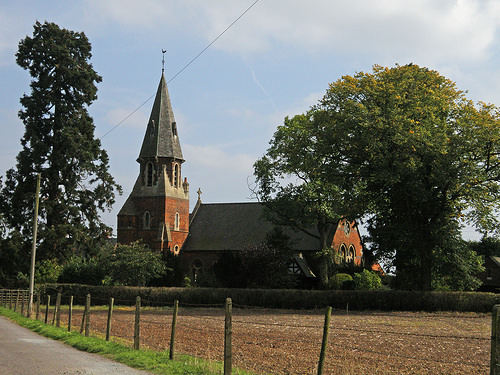Eastern Green

Eastern Green
Eastern Green is a suburb in the west of Coventry, which was formerly a village in Warwickshire. It is currently within the Woodlands Ward of Coventry. Its name relates to its history as the eastern green of the parish of Meriden, which it was a part of before being absorbed into the expanding city of Coventry. Eastern Green was part of the historic Forest of Arden.
Little is known of the ancient history of Eastern Green, but there is evidence of Neolithic settlement (4000-2201 BC) and also Roman settlement north of Upper Eastern Green Lane.
The eastern part of the neighbourhood, east of Alderminster Road, was historically part of the Allesley Hall deer park. In medieval times hunting was a popular pastime of the aristocracy. It appears that the land converted back to agriculture in the 15th Century. In the 19th Century there were very small hamlets in Upper Eastern Green, Lower Eastern Green and Hockley.
The Church of St Andrew was established in 1875 and was built to serve an original congregation of 56 families.

A house which still stands at the corner of Pickford Green Lane and Eastern green Lane once belonged to Major Rabon (Rawbone) of Cromwell’s Army in 1660. In 1669 it was reported to the Bishop that Presbyterian conventicles were being held in this house.
Pond Farm House was probably once within the moat at the rear of the old farm house and occupied land that was recorded as once being the property of The Priory of Stoneley and called Estendmoore. Julines Herring once occupied the farm vacated in 1975 by Mr. T Knowles. Julines Herring was a parson turned Presbyterian who caused Archbishop Laud to threaten “I’ll pickle that Herring”.
Eastern Green’s proximity to Coventry did not mean that this city was easily reached and relative isolation served to define the community which could boast of its own butchers shop, tinsmith, several laundries, a blacksmith and a wheelwright. We are told that it always had two pubs, “The Old Unicorn” and one which rejoiced in having the name of “The Rag and Louse”.
The Unicorn pub can be dated back to the 1850s. From 1850 to 1924 it was known as the Beerhouse, Lower Eastern Green, although on the 1888 OS map it is named as The Unicorn public house. It was originally a cottage on Unicorn Lane. The Wills family, early licensees, were cordwainers who ran the Beerhouse as something of a side line.
In 1937 the new Unicorn was started opposite the old one. However, due to the intervention of the War, it remained a shell. The roof was on but the floorboards had not been put in. It was completed after the War but did not open for business until 1954. The original Unicorn reverted to being a private residence and still stands to this day opposite the new pub and called ‘Unicorn Cottage’. The new Unicorn is an imposing mock Tudor structure, surrounded by trees that screen it and its grounds from the road. From 1989 to 2013 the pub was known as the Scriborne Tavern, but it has now reverted to its original name and operates as a Hungry Horse pub.
Development over the past 25 years has altered the face of Eastern Green with new housing estates built which have added a growing population with over 3200 homes. Further housing development is now going ahead on the formerly Green Belt land adjoining Eastern Green.
